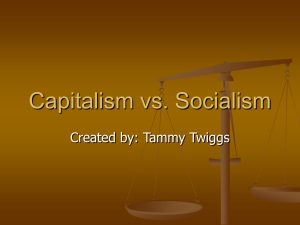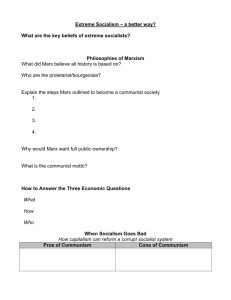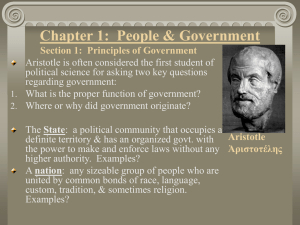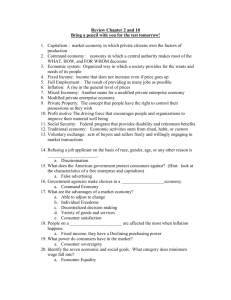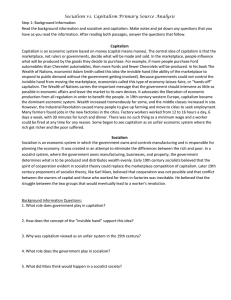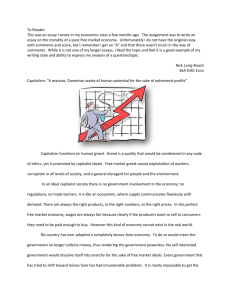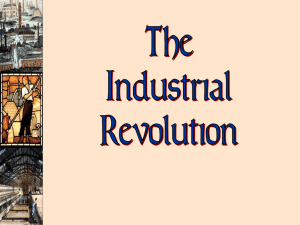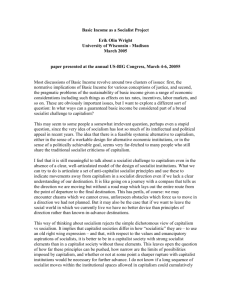Capitalism vs. Socialism: Student Handout
advertisement
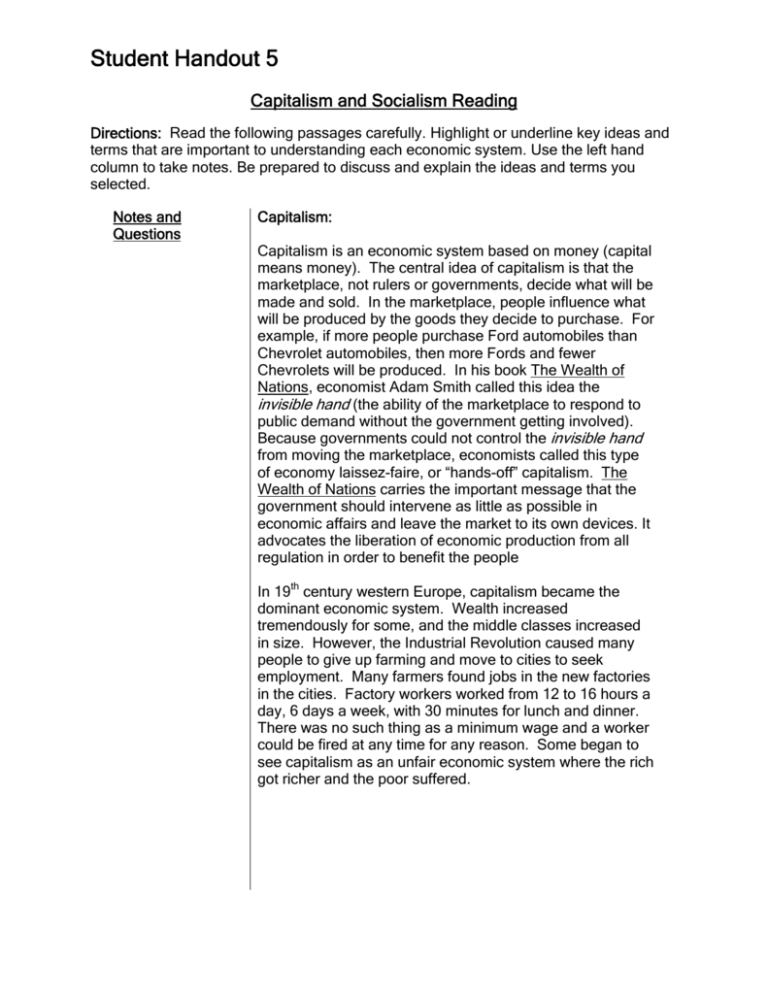
Student Handout 5 Capitalism and Socialism Reading Directions: Read the following passages carefully. Highlight or underline key ideas and terms that are important to understanding each economic system. Use the left hand column to take notes. Be prepared to discuss and explain the ideas and terms you selected. Notes and Questions Capitalism: Capitalism is an economic system based on money (capital means money). The central idea of capitalism is that the marketplace, not rulers or governments, decide what will be made and sold. In the marketplace, people influence what will be produced by the goods they decide to purchase. For example, if more people purchase Ford automobiles than Chevrolet automobiles, then more Fords and fewer Chevrolets will be produced. In his book The Wealth of Nations, economist Adam Smith called this idea the invisible hand (the ability of the marketplace to respond to public demand without the government getting involved). Because governments could not control the invisible hand from moving the marketplace, economists called this type of economy laissez-faire, or “hands-off” capitalism. The Wealth of Nations carries the important message that the government should intervene as little as possible in economic affairs and leave the market to its own devices. It advocates the liberation of economic production from all regulation in order to benefit the people In 19th century western Europe, capitalism became the dominant economic system. Wealth increased tremendously for some, and the middle classes increased in size. However, the Industrial Revolution caused many people to give up farming and move to cities to seek employment. Many farmers found jobs in the new factories in the cities. Factory workers worked from 12 to 16 hours a day, 6 days a week, with 30 minutes for lunch and dinner. There was no such thing as a minimum wage and a worker could be fired at any time for any reason. Some began to see capitalism as an unfair economic system where the rich got richer and the poor suffered. Student Handout 5 Notes and Questions Socialism: Socialism is an economic system in which the government owns and controls manufacturing and is responsible for planning the economy. It was created in an attempt to eliminate the differences between the rich and poor. In a socialist system, where the government owns manufacturing, businesses, and property, the government determines what is to be produced and distributes wealth evenly. Early 19th century socialists believed that the spirit of cooperation evident in socialist theory could replace the marketplace competition of capitalism. Later 19th century proponents of socialist theory, like Karl Marx, believed that cooperation was not possible and that conflict between the owners of capital and those who worked for them in factories was inevitable. He believed that the struggle between the two groups would eventually lead to a workers revolution. Document 1 The Pyramid of Capitalist System Document 2 Writings from Marx and Engels Excerpts from the Communist Manifesto by Friederich Engels and Karl Marx, 1848 “The modern bourgeois (middle class) society…has not done away with class antagonisms (hatred between groups of people). It has but established new forms of struggle in place of the old ones. Modern industry has converted the little workshop of the patriarchal (male) master into the great factory of the industrial capitalist. Masses of laborers, crowded into the factory, are organized like soldiers…. They are slaves of the machine and the manufacturer. Instead of rising as industry progresses, they sink deeper and deeper into poverty….” "Owing to the use of machinery and to division of labor, the work of the proletarians (worker class) has lost all individual character, and consequently, all charm for the workmen. He becomes [a limb] of the machine, and it is only the most simple, most monotonous (boring), and most easily acquired knack (skill or ability), that is required of him.” Excerpt from the Principles of Communism by Friedrich Engels, 1847 “Above all, [the government]… will have to take control of industry and of all the branches of production out of the hands of… competing individuals, and instead institute a system as a whole, that is for the common account (good), according to a common plan, and with the participation of all members of society. It will… abolish (eliminate) competition….Private property must therefore be abolished.” Document 3 Adam Smith, The Wealth of Nations Excerpts from The Wealth of Nations by Adam Smith, 1776 “The sole purpose of all production is to provide the best possible goods to the consumer at the lowest possible price. Society should assist producers of goods and services only to the extent that assisting them benefits the consumer… he [the consumer] intends his own gain; and he is in this, as in many other cases, led by an invisible hand to promote an end which was no part of his intention…. By pursuing his own interest, he frequently promotes that of the society....” “According to this liberal and generous system, therefore, the most advantageous method in which a landed nation can raise up artificers (craftsmen), manufacturers, and merchants of its own, is to grant the most perfect freedom of trade to artificers, manufacturers and merchants of all nations.” Document 4 Ralph Waldo Emerson, The Conduct of Life Excerpt from The Conduct of Life, by Ralph Waldo Emerson, 1860 “Wealth brings with it its own checks and balances. The basis of a [capitalistic] economy is noninterference [by the government]. The only safe rule is found in the self adjusting meter (measure) of demand and supply. Open the doors of opportunity to talent and virtue (good character) and they will do themselves justice, and property will not be in bad hands. In a free and just commonwealth (society), property rushes from the idle (non-working) and imbecile (fool) to the industrious (hard-working), brave and persevering (dedicated).” Student Handout 6 Document Analysis Guide Directions: As you read and analyze the primary source documents, use this chart to organize your ideas. You will use this chart when you work on the writing task, so write clearly and accurately. Document and Source Economic System Do the ideas of the document represent capitalism or socialism? Evidence and Explanation Opposite View Key quote, image, or phrase that shows what system is being represented. Explain how. How would someone with the opposing view, (capitalist or socialist) criticize this document? Evidence and Explanation Opposite View Document 1: The Pyramid of Capitalist System Document 2: Writings from Marx and Engels Document and Source Economic System Student Handout 6 Do the ideas of the document represent capitalism or socialism? Document 3: Adam Smith, The Wealth of Nations Document 4: Ralph Waldo Emerson, The Conduct of Life Key quote, image, or phrase that shows what system is being represented. Explain how. How would someone with the opposing view, (capitalist or socialist) criticize this document?
